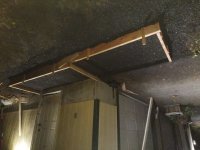ryanjg117
Member
- Joined
- May 18, 2015
- Messages
- 333
I need to pour a smallish (3' x 10') concrete pad for the side entry of a workshop. Not a concrete guy, but a few of the tutorials I've seen online suggest a base layer of 3/8 or 5/8 minus (rocks/pebbles). Others I've spoken with suggest it's not necessary as Pacific Northwest soil tends to be quite hard. I would describe the soil under the pad as fairly "loamy" but not very springy. Attaching some pictures below.
Pics:https://photos.app.goo.gl/9nx6nZKc9CQNKsC68
https://photos.app.goo.gl/DAL5EudjWx42fKHW8
Not the best pics as it was getting pretty dark, sorry.
Just wondering if I need to add that base layer of rocks, or if compacting the current soil will be fine.
This is a side entry to a garage and won't ever see a tremendous amount of weight. I'm also planning to reinforce with some wire mesh.
Pics:https://photos.app.goo.gl/9nx6nZKc9CQNKsC68
https://photos.app.goo.gl/DAL5EudjWx42fKHW8
Not the best pics as it was getting pretty dark, sorry.
Just wondering if I need to add that base layer of rocks, or if compacting the current soil will be fine.
This is a side entry to a garage and won't ever see a tremendous amount of weight. I'm also planning to reinforce with some wire mesh.

